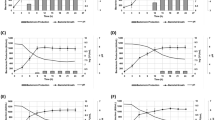Abstract
Seven microbial peptide inhibitors—chymostatin, antipain, elastatinal, leupeptin, pepstatin, bestatin, and phosphoramidon—were tested for their efficiency to inhibit thermitase, a thermostable serine protease fromThermoactinomyces vulgaris. Chymostatin and antipain were the most effective inhibitors, with Ki values of 7×10−8 M and 2×10−7 M, respectively. Except for leupeptin, all inhibitors resist hydrolysis by thermitase. Leupeptin, however, is cleaved by thermitase between the two leucylresidues. Further, a close relationship in specificity between thermitase and subtilisin BPN′ and their distinct discrimination from elastase specificity was demonstrated by using these inhibitors.
Similar content being viewed by others
Literature Cited
Aoyagi, T., Umezawa, H. 1975. Structure and activities of protease inhibitors of microbial origin, pp. 429–454. In: Reich, E., Rifkin, D. B., Shaw, E. (eds.), Proteases and biological control. Cold Spring Harbor, New York.
Beynon, R. J., Brown, C. P., Butler, P. E. 1981. The inactivation of Streptomyces derived proteinase inhibitors by mammalian tissue preparations. Acta Biologica et Medica Germanica40:1539–1546.
Brömme, D., Kleine, R. 1984. Substrate specificity of thermitase, a thermostable serine protease fromThermoactinomyces vulgaris. Current Microbiology11:93–100.
Fischer, G., Demuth, H.-U., Barth, A. 1983.N, O-Diacylhydroxylamines as enzyme-activated inhibitors for serine proteases. Pharmazie38:249–250.
Fittkau, S., Smalla, K., Pauli, D. 1984. Thermitase: a thermostable serine protease. IV. Kinetic investigations on the binding ofN-acylated peptide ketones as substrate analogous inhibitors. Biochimica et Biomedica Acta43:887–899.
Jahreis, G., Smalla, K., Fittkau, S. 1984. Synthese von substratanalogen Peptidchlormethylketonen als potentielle irreversible Enzyminhibitoren. Journal für Praktische Chemie326:41–47.
Kleine, R. 1982. Properties of thermitase, a thermostable serine protease fromThermoactinomyces vulgaris. Acta Biologica et Medica Germanica41:89–102.
Kleine, R., Rothe, U., Kettmann, U., Schelle, H. 1981. Purification, properties and application of thermitase, a microbial serine protease, pp. 201–212. In: Turk, V., Vitale, L. (eds.), Proteinases and their inhibitors: structure, function and applied aspects. Pergamon, Lyubilyana-Oxford.
Kleine, R., Kettmann, U. 1982. Separation and comparative characterization of the cationic protease and anionic protease from the culture medium ofThermoactinomyces vulgaris. Hoppe-Seyler's Zeitschrift für Physiologische Chemie363:843–853.
Langner, J., Wakil, A., Zimmermann, M., Ansorge, S., Bohley, P., Kirschke, H., Wiederanders, B. 1973. Aktivitätsbestimmung proteolytischer Enzyme mit Azokasein als Substrat. Acta Biologica et Medica Germanica31:1–18.
Robertus, J. D., Alden, R. A., Birktoft, J. J., Kraut, J., Powers, J. C., Wilcox, P. E. 1972. An X-ray crystallographic study of the binding of chloromethylketone inhibitory to subtilisin BPN′. Biochemistry11:2439–2449.
Rothe, U., Brömme, D., Könnecke, A., Kleine, R. 1982. Investigations on the substrate specificity of thermitase, a thermostable serine protease fromThermoactinomyces vulgaris. Acta Biologica et Medica Germanica41:447–450.
Schechter, I., Berger, A. 1967. On the size of the active site of proteases. I. Papain. Biochemical and Biophysical Research Communications27:157–162.
Umezawa, H., Aoyagi, T. 1983. Trends in research of low molecular weight protease inhibitors of microbial origin, pp. 3–15. In: Katunuma, N., Umezawa, H., Holzer, H. (eds.), Proteinase inhibitors: medical and biological aspects. Springer-Verlag, Berlin.
Author information
Authors and Affiliations
Rights and permissions
About this article
Cite this article
Brömme, D., Kleine, R. Use of microbial peptide inhibitors for characterization of the substrate specificity of thermitase, a thermostable serine protease fromThermoactinomyces vulgaris . Current Microbiology 11, 317–320 (1984). https://doi.org/10.1007/BF01567698
Issue Date:
DOI: https://doi.org/10.1007/BF01567698




